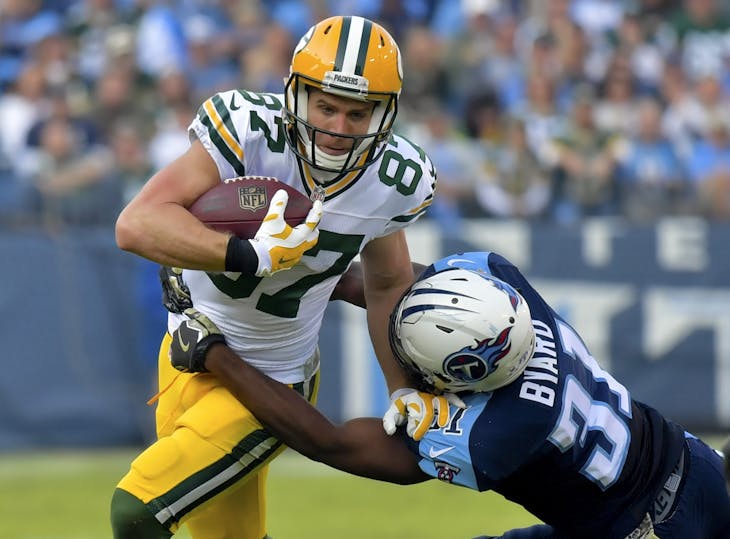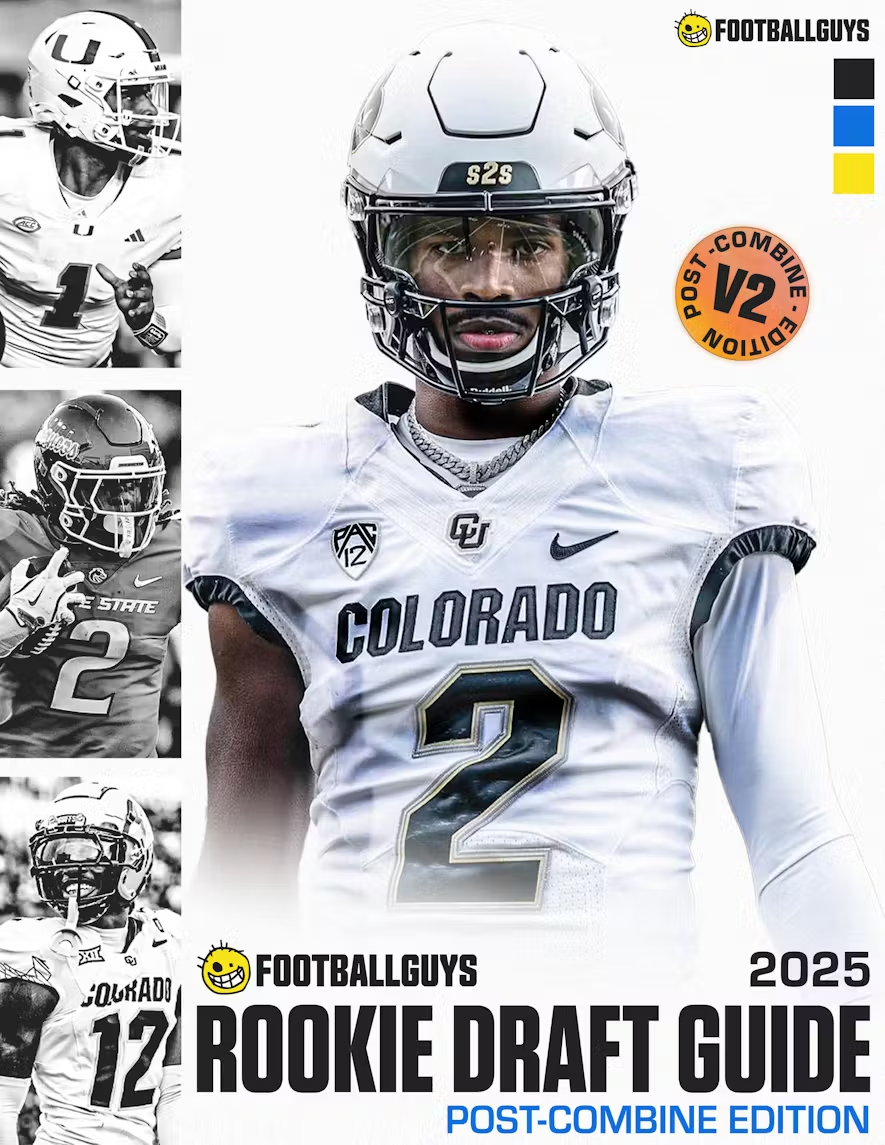
A Costly Preseason
He got right up and he ran off the field.
It was a good sign, we figured, despite the noticeable limp. Those of us that had stockpiled MFL10 shares and those of us with early drafts had at least some hope. Maybe it was just a twisted ankle like they said on the broadcast. Or perhaps a pulled muscle.
But about a day later news out of Green Bay laid out the painful truth: Jordy Nelson was lost for the 2015 season. It was more painful than this. For the Packers, it blew a hole in their offense, which sputtered down the stretch as teams figured out Randall Cobb isn’t good enough to handle WR1 duties, and there was little talent behind him on the depth chart. For fantasy owners, it meant losing 2014’s No. 3 overall wide receiver and a weekly safety valve with touchdown upside in DFS.
The good news is all reports indicate that Nelson has fully recovered and should be ready to take on the 2016 season at full speed come Week 1. But does his return mean the Packers will reestablish themselves as one of the league’s best offenses? Lest we forget that in 2014, they became the first team to support two wide receivers with at least 90 catches, 1,200 yards and 12 touchdowns each. Last year, they failed to even field a 1,000-yard receiver. It’s makes us wonder, just how valuable is Nelson?
The Definition of a No. 1 Receiver
Recently there was some debate on Twitter over what the definition of what it means to be a WR1.
@KarlSafchick can win in multiple areas of the field. adds value to targets with at least one of RAC/speed/ball skills. difficult to defend
— Sigmund Bloom (@SigmundBloom) June 27, 2016
@KarlSafchick not: one-dimensional WR. WR who can be blotted out by a certain kind of CB or scheme. WR who can't contribute in some areas
— Sigmund Bloom (@SigmundBloom) June 27, 2016
I like Sigmund’s answers. But if those are the parameters then it’s fair to say that not every team has a guy who fits this description. In that sense, a team like the Raiders or Chiefs losing their No. 1 receiver is a whole lot different than a team like the Packers losing theirs.
If anything, Nelson’s injury highlighted just how much the Packers need him. Sure, they backed into the playoffs after struggling down the stretch, and even won a playoff game on the road. But a year-over-year comparison shows how much this offense dropped off in 2015.
| Year | Total Yards | Rank | Points For | Rank | Passing Yards | Rank |
|---|---|---|---|---|---|---|
| 2015 | 5353 | 23rd | 368 | 15th | 3503 | 25th |
| 2014 | 6178 | 6th | 486 | 1st | 4261 | 8th |
| 2013 | 6404 | 3rd | 417 | 8th | 4268 | 6th |
| 2012 | 5751 | 13th | 433 | 5th | 4049 | 9th |
| 2011 | 6482 | 3rd | 560 | 1st | 4924 | 3rd |
| 2010 | 5730 | 9th | 388 | 10th | 4124 | 5th |
| 2009 | 6065 | 6th | 461 | 3rd | 4180 | 7th |
| 2008 | 5618 | 8th | 419 | 5th | 3813 | 8th |
After being a powerhouse for seven straight years, Aaron Rodgers and Company looked pedestrian in comparison last season. Rodgers went from being 2014’s MVP to having his worst statistical season since becoming the starter. Was this all the result of losing Nelson?
That would be a foolish assumption. The Packers’ offensive line was a mess. Rodgers was sacked 46 times, the second most trailing only Blake Bortles (51). As the season wore on it became painfully obvious that behind Cobb, they don’t have a reliable WR3, and the running game was just as unreliable.
So no, it can’t all be Nelson. But his absence had a trickle-down effect on this entire offense and they simply looked incomplete without him. That is the definition of a WR1: The player that changes the playbook. The one thing we can definitively point out as “This is why the Packers had their worst season in a decade; because No. 87 wasn’t on the field.” Nelson was undervalued before breaking out in 2014. Now he’s in the conversation of being a top-five player at his position.
Jerry Rice, Kenny Britt and the ACL Family
There may have been a time when a torn ACL meant a tragic end to the career of a football player. If not rehabbed correctly and given enough time to recover, results aren’t great. If there is a bit of a silver lining, it’s that Nelson tore his ACL in August and will have a full year to recover. Further, it seems medicine and technology have greatly improved over the last decade. See Adrian Peterson.
But there’s also the matter of age. Nelson just turned 31: not old, but about that age production begins to decline. Per Adam Harstad's model, the "Death Rate" of wide receivers sees a sudden and significant bump from age 30 to age 31. Add a serious knee injury to the equation and there’s plenty of reason for concern.
That’s why we draw on a few historical examples and hope to find a clue about how well wide receivers recover. Most recently, Jeremy Maclin missed the entire 2013 season after tearing his ACL. Since then, he has caught 173 passes for 2,417 yards and 18 touchdowns on two different teams. Basically, he’s been playing at Nelson’s floor.
But he is also three years younger. Jerry Rice tore his ACL at the ripe age of 35. He went on to have a few productive seasons (also a few not-so-productive seasons) and logged 492 catches and another 42 touchdowns before retiring.
That, of course, might have something to do with Rice being one of the greatest receivers of all time. More cautionary tales come from promising players like Kenny Britt and Mario Manningham. Both suffered major knee injuries and neither recovered. Manningham battled injuries his whole career until finally retiring one year after tearing his ACL. Britt, after hauling in 14 catches for 271 yards and three touchdowns in the first two game of the 2011 season, tore his ACL in Week 3 and has struggled with consistency ever since.
Wes Welker’s best seasons came after his ACL tear in 2009. If anything, he’s our best comparison since he landed on one of the best teams in the NFL with one of the best quarterbacks. Their styles are completely different, but their situations are not. Nelson is a better player and a prototypical WR1, but he’s also asked to do a lot of the things beyond being an outside threat.
Putting this all together, we won’t know how well he will respond when he takes the field this fall. But we have plenty of examples that suggest the ACL won’t be an issue. And since he’s already catching passes from Rodgers, albeit in light drills, there’s not much concern about him being in football shape and back on the same page as his quarterback.
Pros
- He is the No. 1 receiver on one of the best offenses in the league.
- The ACL injury looks to be behind him and historical evidence suggests it won’t be an issue.
- The Packers offensive line will be finally healthy. We currently have them ranked second overall.
Cons
- He’s a 31-year-old receiver coming off of knee surgery.
- His ADP is nearing the first round.
- There’s no guarantee he’ll be able to play at the level he once did pre injury.
Projections
| Year | Analyst | Rec | Yards | TD |
|---|---|---|---|---|
| 2016 | PROJ-Dodds | 89 | 1219 | 9 |
| 2016 | PROJ-Henry | 90 | 1390 | 11 |
| 2016 | PROJ-Wood | 94 | 1400 | 9 |
| 2016 | PROJ-Tremblay | 85 | 1249 | 8 |
Final Thoughts
Historical comparisons aside, the best way to judge Nelson’s situation is by comparing his current ADP to his expected value. It’s okay to hope for another 2014 type of season (98 catches, 1,519 yards, 13 touchdowns), but that’s awfully optimistic. What’s interesting is he’s being drafted as high, or higher, than he was before his injury last season. So despite being a year removed from a serious knee injury, mid-summer mockers like Nelson more than they did at this time last year.
Part of that might have to do with the “do the opposite” or “Zero RB” trend that so many players have adopted. If you end up with a late round draft pick, Nelson is one of the few wide receivers worth taking at his price.
Other View Points
Matt Waldman believes that Nelson will provide fantasy owners with an underrated WR1 option.
Adam Zdroik makes the case for selecting Nelson above Alshon Jeffery this fall.
Nelson claims that if there were a game Sunday, he would be playing in it.

_png)
